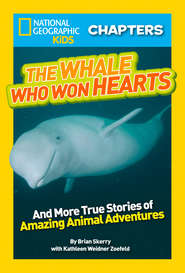По всем вопросам обращайтесь на: info@litportal.ru
(©) 2003-2024.
✖
Witness to Disaster: Tsunamis
Автор
Год написания книги
2019
Настройки чтения
Размер шрифта
Высота строк
Поля
Chapter 2: “A Wave 800 Feet Tall”: Tsunami Science
Chapter 3: “Everything Had Become Sea”: Some Historic Tsunamis
Chapter 4: “Out of the Blue”: Tsunami Warnings and Safety
Glossary
Further Reading and Research
Bibliography
Interviews by the Authors
Acknowledgments
Index
Introduction: Japan Tsunami
On the afternoon of March 11, 2011, a humungous earthquake struck northeastern Japan. It measured 9.0 on the magnitude scale. Only three larger quakes have shaken our planet in the past century.
The earthquake occurred when two large chunks of our planet’s crust fractured beneath the sea off the coast of Japan. The rupture thrust part of the ocean floor under the island nation, dropping its coastline two feet while lifting the land beneath the sea. This double motion caused the Pacific Ocean waters to slosh like soup in a bowl, creating massive waves called tsunami.
Because Japan is one of the most earthquake-prone places on our planet, the Japanese people are well prepared for both earthquakes and tsunamis. Homes and large buildings in Japan are built to withstand large quakes. A state-of-the-art tsunami warning system is in place, and Japanese children and adults undergo regular drills to make sure they know what to do during such disasters.
But nothing could prepare the residents of northeastern Japan for the gigantic waves that hit their coast an hour and a half later. Walls of water as tall as 30 feet (9 meters)—the height of a three-story building—slammed into coastal Japanese cities at the speed of a jet airplane. The water flooded areas more than five miles inland, killing tens of thousands of residents.
The power of the water was so intense that tsunami warnings were issued for coastal Hawaii, 3,850 miles (6,200 kilometers) from Japan. Waves taller than three feet (one meter) high hit the Hawaiian coast seven and a half hours after the quake struck Japan.
Crescent City, California, lies 4,763 miles (7,700 kilometers) from the coast of Japan. Nevertheless, ten hours after the earthquake, an eight-foot (two-meter) tsunami wave slammed into that harbor city, destroying a pier and reducing dozens of boats to rubble.
Sophisticated tsunami warning systems throughout the Pacific Ocean prevented even greater loss of life. You will learn more about tsunamis and the systems that warn people about them in the following chapters.
CHAPTER 1
“Like Niagara Falls Moving Towards Us”
Indian Ocean Tsunami of 2004
On December 26, 2004, an earthquake shook our planet so violently that it wobbled slightly on its axis.
The quake struck shortly after dawn, beneath the floor of the Indian Ocean. Lasting about nine minutes, this was the third most powerful earthquake ever measured. It unleashed a natural disaster of almost unimaginable proportions.
A large earthquake that occurs beneath or near the ocean can violently disturb seawater, creating a series of waves collectively known as a tsunami. Out at sea, tsunami waves move at hundreds of miles per hour but appear as just bumps on the ocean’s surface. Approaching shore, they slow down dramatically, but can pile up into titanic walls of water. The December 26, 2004, earthquake triggered tsunami waves that raced toward the shores of more than a dozen countries along the Indian Ocean. Some locales were struck by waves up to 110 feet tall—the height of an 11-story building.
One of the first places hit was Indonesia’s Simeulue Island, only 25 miles from the site of the quake. Waves began pounding the island a few minutes after the shaking stopped. Reaching 50 feet in height, the waves destroyed entire villages, yet only seven of the island’s 78,000 people died. Warnings handed down by Simeulue islanders for generations accounted for the low death toll.
“Chairs, pieces of houses, tables, and trees were floating through the water, which was on both sides of our train as far as the eye could see.”
Eranthie Mendis, who survived the 2004 Indian Ocean tsunami aboard a train in Sri Lanka
The Indian Ocean tsunami of 2004 affected millions of people.
“Suddenly we saw a huge wave coming… My first impression was, it looked like Niagara Falls moving towards us.”
Professor Dipak Jain, recalling his family’s close call with a tsunami wave on December 26, 2004, in Phuket, Thailand
Long ago, an earthquake launched a tsunami that devastated Simeulue Island. Ever since, the islanders have taught their young people to run to the hills if they feel an earthquake. When the quake struck in late 2004, islanders shouted “Semong! Semong!”—their word for tsunami. By the time the waves arrived, nearly everyone on the island had taken refuge on high ground.
Thirty minutes after the quake, the first in a series of waves struck the Indonesian island of Sumatra. Banda Aceh on Sumatra was the closest major city to the earthquake. Huge waves that sped inland as far as three miles destroyed two-thirds of Banda Aceh and killed tens of thousands of its inhabitants. In all, the tsunami claimed 168,000 lives in Indonesia. On that single day, Indonesia lost more people than have died in all the tornadoes, hurricanes, earthquakes, floods, volcanic eruptions, and tsunamis that have ever struck the United States.
An hour after Indonesia was devastated, waves began to barrage beaches in southern Thailand. On Maikhao Beach in Phuket, Thailand, a ten-year-old schoolgirl from England was vacationing with her parents and seven-year-old sister. Two weeks earlier, in geography class, Tilly Smith had learned about how earthquakes trigger tsunamis. Tilly had been impressed by the fact that, before a tsunami wave strikes, the sea sometimes recedes from the shore.
That Sunday morning, the day after Christmas, Tilly was on the beach with her family when she noticed something odd. “There were bubbles and the tide went out all of a sudden,” she later explained. Remembering her geography lessons, Tilly warned her family that a tsunami wave might be coming. As the Smiths left the beach, they told other tourists to also seek higher ground. Thanks to Tilly’s warning, by the time the giant waves struck, Maikhao Beach had been evacuated, and no lives were lost there.
On another of Thailand’s beaches, several children were reportedly saved when they were placed on an elephant’s back and carried to safety before the waves could swallow them. However, tsunami waves drowned 8,000 other people along Thailand’s coast.
A half-hour after striking Thailand, waves reached Sri Lanka. As many as six separate waves slammed into this island country. A tragic incident in Sri Lanka involved a train that ran along the coast. About 1,500 passengers were crowded aboard the Queen of the Sea when it was struck by two separate waves. More than 800 passengers drowned, making this one of the deadliest railroad disasters ever. When the waves finished with Sri Lanka, 35,000 people had died.
At about the time the tsunami struck Sri Lanka, waves also hit India, just 20 miles to the north. The waves that rammed India’s coast surged as far as two miles inland and killed nearly 20,000 people.
Other Asian countries where waves claimed lives included Myanmar, Malaysia, and the Maldives. The tsunami even reached Africa’s eastern coast, killing 300 people in Somalia. The most distant locale where the tsunami took lives was South Africa. There, high water killed several people 16 hours after the earthquake had occurred 5,000 miles to the northeast.
WITNESS TO A TSUNAMI
“…Then the second wave came—more like a rise of water—and came into our train car. We climbed on the seats but the water rose in seconds. It reached our necks and then I was completely underwater and so was my mother and everyone else in the train car.”
Eranthie Mendis, describing her ordeal aboard the Queen of the Sea in Sri Lanka
Amidst all the death and destruction were a few amazing survival stories. Malawati Daud, a 23-year-old woman from Sumatra, was swept out to sea with her husband. He soon disappeared beneath the water. Malawati, who couldn’t swim and was pregnant, seemed to be doomed. “I was thrashing in the water trying to keep my head up when I chanced upon a tree,” Malawati later explained. She survived by holding onto the floating tree, a sago palm, and sustained herself by eating its fruit and bark. After clinging to the tree for five days, she was rescued by a fishing boat.
Ari Afrizal was building a house in the town of Calang, Sumatra, when a wave sucked him out to sea. Ari survived the first day by clutching a log. He then climbed into a damaged wooden boat in which he drifted for a time. After that he built a raft out of passing debris. At first he plucked floating coconuts from the water, but then, he later related, “for three days I didn’t eat anything. I gave up all hope of living.” On January 9, 2005, Ari was spotted by a ship and rescued. He had spent two full weeks in the ocean and had drifted 200 miles from Calang.
Вы ознакомились с фрагментом книги.
Приобретайте полный текст книги у нашего партнера:
Приобретайте полный текст книги у нашего партнера:











